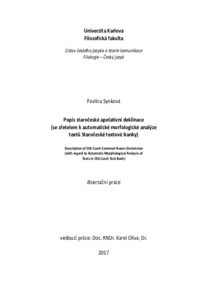Popis staročeské apelativní deklinace (se zřetelem k automatické morfologické analýze textů ve Staročeské textové bance)
Description of Old Czech Common Nouns Declension (with regard to Automatic Morphological Analysis of Texts in Old Czech Text Bank)
dizertační práce (OBHÁJENO)

Zobrazit/otevřít
Trvalý odkaz
http://hdl.handle.net/20.500.11956/86563Identifikátory
SIS: 105475
Kolekce
- Kvalifikační práce [23975]
Autor
Vedoucí práce
Oponent práce
Petkevič, Vladimír
Vepřek, Miroslav
Fakulta / součást
Filozofická fakulta
Obor
Český jazyk
Katedra / ústav / klinika
Ústav českého jazyka a teorie komunikace
Datum obhajoby
23. 6. 2017
Nakladatel
Univerzita Karlova, Filozofická fakultaJazyk
Čeština
Známka
Prospěl/a
Klíčová slova (česky)
stará čeština, morfologie, apelativa, deklinační typ, alternace, hlásková změna, lemmatizace, tagováníKlíčová slova (anglicky)
Old Czech, morphology, common nouns, declension type, alternation, sound change, lemmatization, taggingPráce přináší explicitní popis staročeské apelativní deklinace, který může sloužit jako základ pro automatické vygenerování tvarů spojených s morfologickými charakteristikami a lemmatem. Tyto tvary mohou být poté využity pro přiřazování morfologických kategorií (rodu, čísla a pádu) a lemmatu k tvarům vyskytujícím se v elektronizovaných staročeských textech. Práce tak vytváří podklady pro první krok k přeměně textových bank, které v současnosti pro staročeské období existují, v šíře využitelný nástroj lingvistického výzkumu. Staročeským obdobím se přitom ve shodě s obecně přijatou periodizací myslí období od vzniku souvislých českých textů zhruba do roku 1500. Substantiva byla vybrána proto, že v současné češtině pokrývají zhruba 30 % textu, tedy nejvíce ze všech slovních druhů. V celé práci se zohledňují staročeské texty pouze v transkripci užívané v textech Staročeské textové banky budované v Ústavu pro jazyk český AV ČR, v. v. i. Pro automatickou morfologickou analýzu představuje transkripce velké usnadnění, protože standardizuje písmo i pravopis, zároveň je však třeba mít na zřeteli, že každá transkripce je interpretací a je do jisté míry závislá na rozhodnutí editora textu. V práci se pro popis staročeské apelativní deklinace využívají historické mluvnice, staročeské texty a slovníky staré...
The thesis aims at explicit description of Old Czech common nouns declension with regard to its application in a tool for automatic morphological analysis of (digitized) texts in Old Czech. This means that this description is intended to serve as a basis for automatic generation of word forms (jointly with their appropriate morphological information and lemma) which will then be used for assigning morphological categories (gender, number, case) and lemma to word forms occurring in Old Czech digitized texts. The thesis thus develops a base for the first step in transformation of text banks (which currently exist for the Old Czech period) into an Old Czech corpus offering more possibilities for linguistic research. The Old Czech period is defined as a period from the beginning of the 14th century (more precisely from the period when first coherent texts written in Czech appeared) approx. to the end of the 15th century. Nouns were chosen for this work, because they cover approx. 30% of texts in current Czech (which is the highest percentage from all parts of speech). Old Czech texts are taken into account only in a transcribed form (based on transcription rules used in the Old Czech Text Bank developed at the Institute of the Czech Language of the Academy of Sciences of the Czech Republic). On the one...
